
| Home | About Us | Contribute | Bookstore | Advertising | Subscribe for Free NOW! |
| News Archive | Features | Events | Recruitment | Directory |
News
5 August 2010
Intel takes further step toward Tbit/s data transmission
Intel has combined developments over the past several years to create the first 50Gbit/sec (Gbps) optical data link using silicon optoelectronic technology with hybrid indium phosphide (InP) infrared laser diodes. The ‘concept vehicle’ demonstrator system was on show at the Integrated Photonics Research, Silicon and Nano Photonics conference (IPR 2010) in Monterey, CA last week (25–28 July).
The system (Figure 1) consisted of four InP lasers of different emission wavelengths coupled to four silicon modulators capable of 12.5Gbps data speeds. The four signals are then combined to give the 50Gbps headline speed. After transmission, the signals are separated and detected in silicon-germanium (SiGe) photodetectors.
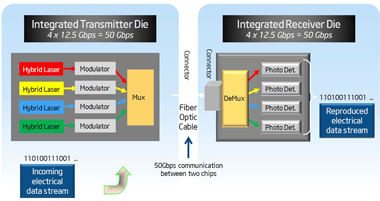
Figure 1: Optical 50Gpbs interconnect system demonstrated by Intel.
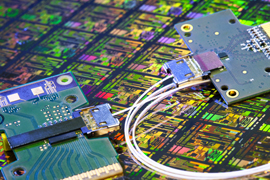 Picture (right): Transmit module.
Picture (right): Transmit module.
The company hopes that the technology will become even faster, aiming at the terabit/sec (1000Gbps) level (Table 1). Higher speed is being sought through increasing the performance of the modulators and through increasing the number of lasers with different wavelengths. Intel believes that the technology will “allow computer makers to completely rethink traditional system design from netbooks to supercomputers” based on its low cost and high speed.
Modulator speed (Gbps) |
Number of channels |
Data rate |
12.5 |
x4 |
50Gbps |
12.5 |
x8 |
100Gbps |
25 |
x16 |
400Gbps |
40 |
x25 |
1Tbps |
Table 1: Intel’s proposed route to 1Tbit/sec.
Server farms and datacenters would benefit from eliminated bottlenecks and savings from replacing many cables with one fiber, consuming less energy, Intel believes. Further application could come from the high-data-rate needs of new 3D television formats.
The 50Gbps transmission speed is the equivalent of one high-definition (HD) movie per second. The use of optical fiber enables higher-speed transmission over longer distances compared with what is available from using traditional copper wiring. Today’s electronics devices are limited to interconnections of at most a few inches of copper for the highest-speed data.
Intel has been working towards optical interconnects for some time. By integrating laser light emitters with silicon-based light-handling technologies, the company believes that it can produce precision devices at much lower cost at high volume compared with existing assembly technologies that are often built semi-automatically or even by hand.
In 2006, the company announced that it had developed technology with University of California Santa Barbara (UCSB) to integrate indium phosphide lasers with silicon optoelectronic structures using plasma-enhanced bonding techniques. The individual lasers are then etched out of the hybrid material.
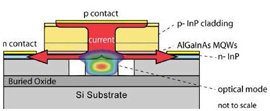
Figure 2: Hybrid InP/silicon laser schematics.
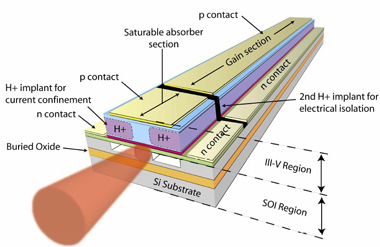
These laser devices were based on aluminum gallium indium arsenide (AlGaInAs) multi-quantum well active regions that emit light into silicon waveguides (Figure 2). In 2008, Intel developed gratings to vary the laser output wavelength (Figure 3).
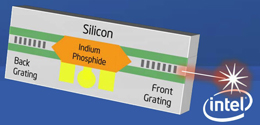 Figure 3: Lasers with etched gratings added to enable wavelength tuning.
Figure 3: Lasers with etched gratings added to enable wavelength tuning.
To put signals into the laser light beams, the Intel system uses silicon modulators. Intel announced 1GHz silicon modulators in 2004, increasing this to 40Gbit/sec in 2007. Modulators allow better signaling performance compared with direct modulation of the laser itself. The multiplexing is achieved passively, combining signals on different-wavelength laser beams.
The detection end of the system consists of a demultiplex system followed by silicon-germanium photodiodes. Intel announced a p-i-n photodiode capable of 40Gbit/sec in 2007 and an avalanche photodetector (in conjunction with US Defense Advanced Research Projects Agency) with a gain–bandwidth product of 340GHz in 2008.
Intel stresses that these results are separate from its ‘Light Peak’ project, which is targeting nearer-term applications connecting systems to high-speed optical networks. In January, Intel said it was getting ready to ship Light Peak components later this year.
![]() Search: Intel InP infrared laser diodes Tbit/s data transmission AlGaInAs
Search: Intel InP infrared laser diodes Tbit/s data transmission AlGaInAs
Visit: www.intel.com
The author Mike Cooke is a freelance technology journalist who has worked in the semiconductor and advanced technology sectors since 1997.